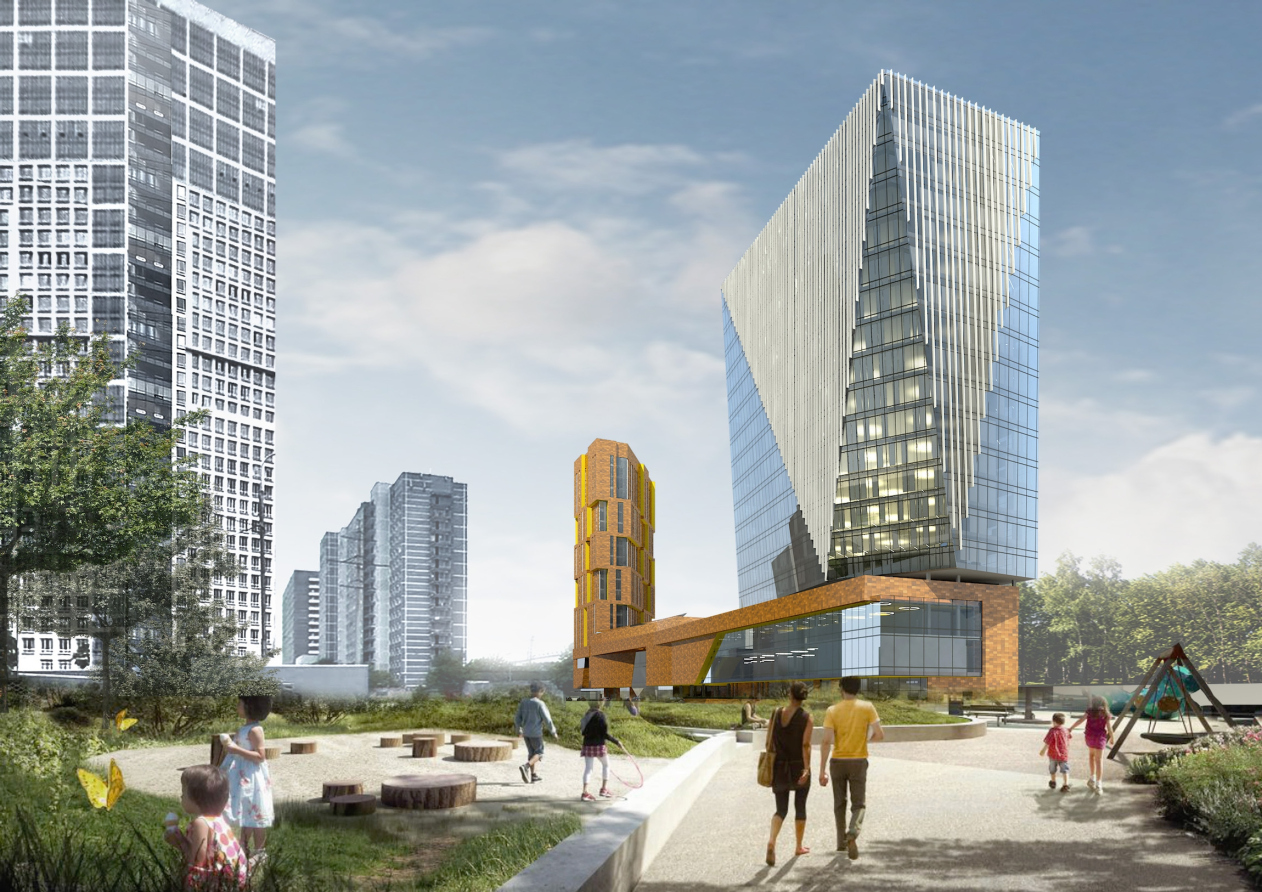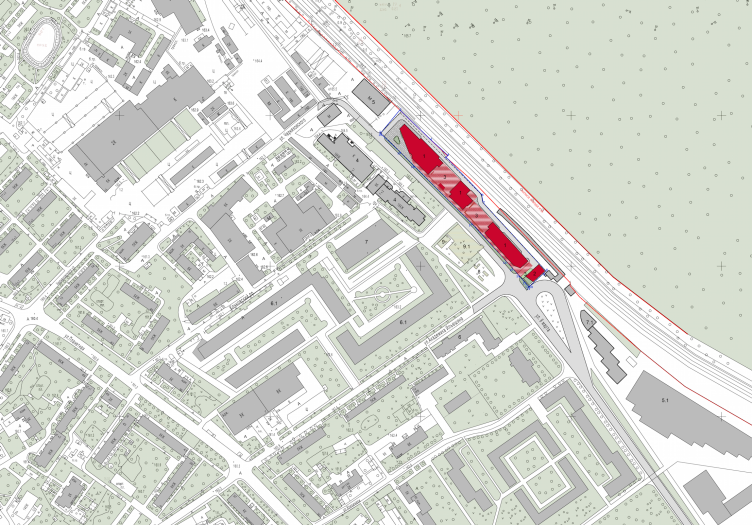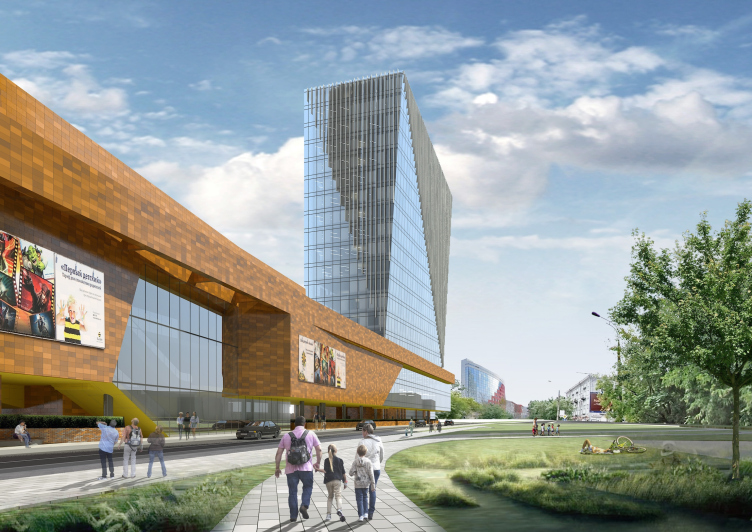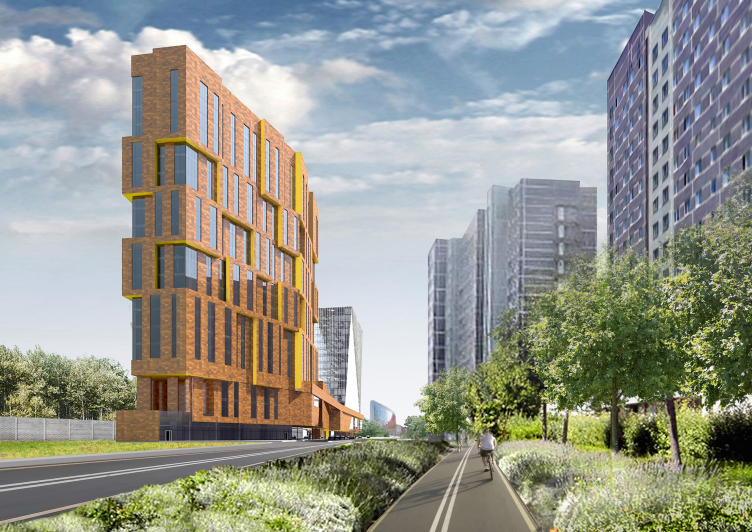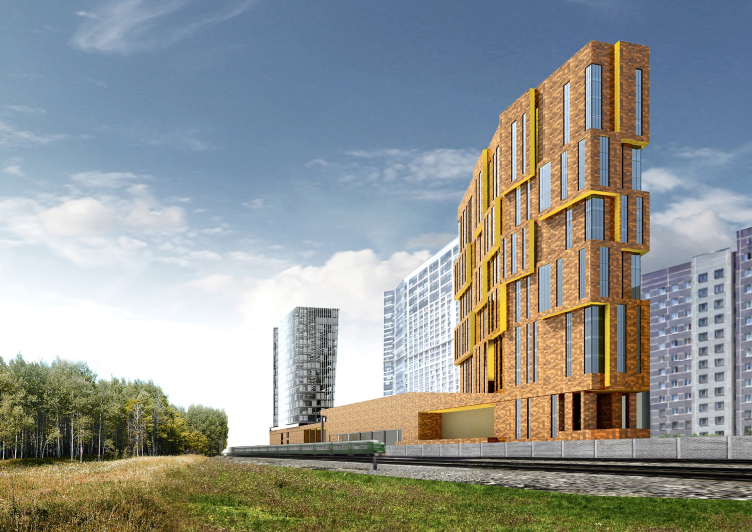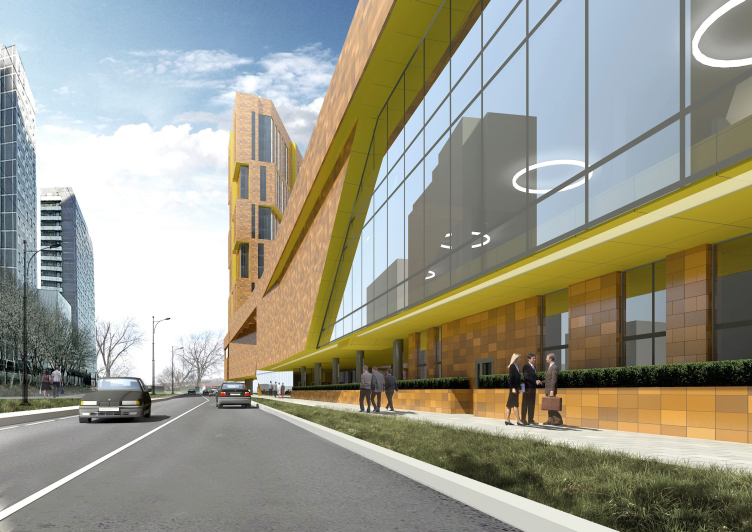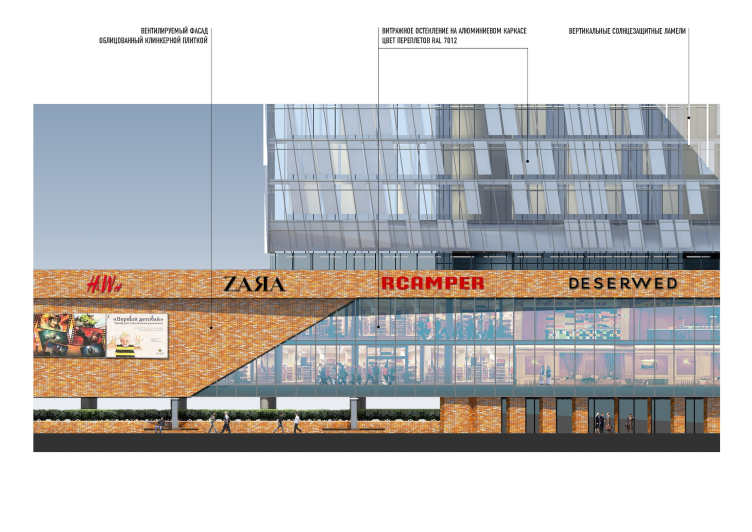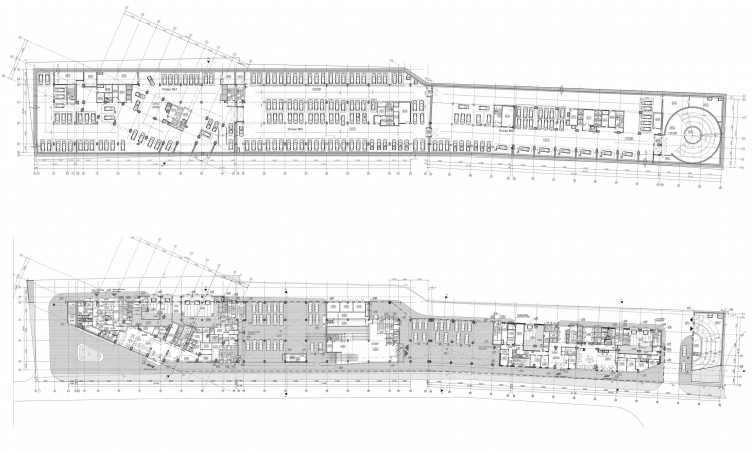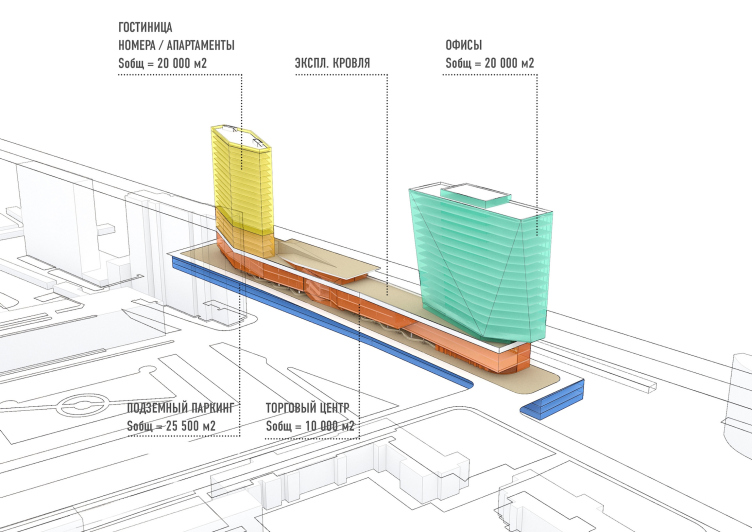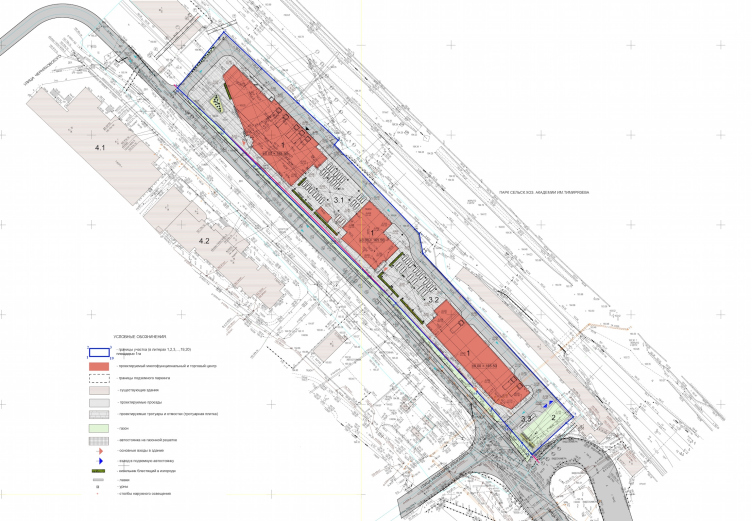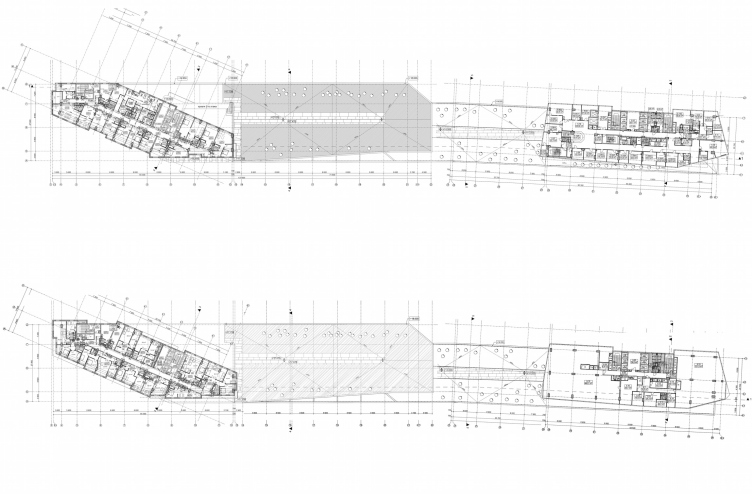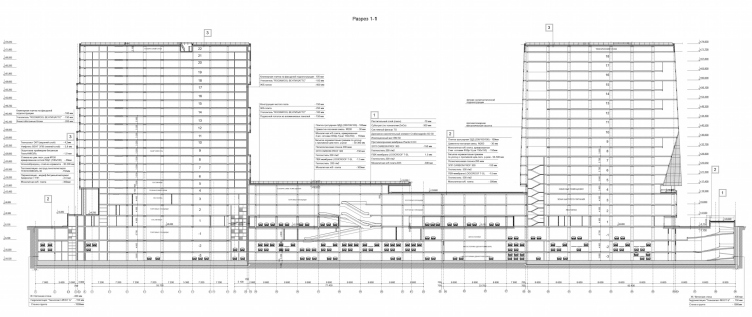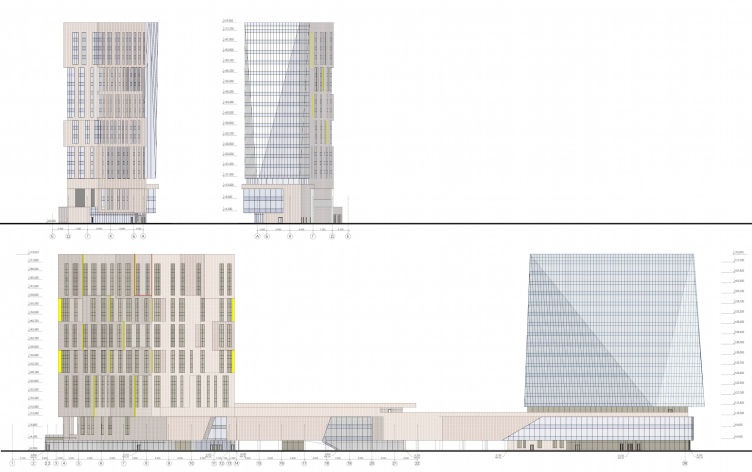To do the project justice, one must mention straight away that the park of the Timiryazevskaya Agricultural Academy is only within an arm's reach on the master plan: in actuality, the park and the designed complex are separated by a bunch of railroad tracks. From its opposite side, the hectare-strong land site is propped by a driveway and the residential buildings of the Akademika Ilyushina street, and squeezing into it the required 50 000 square meters of usable space turned out to be quite a tough call. Out of these, 20 thousand square meters fall on the hotel and office function each, the remaining ten occupied by a shopping mall.
Multifunctional complex and shopping mall at the Akademika Ilyushina Street © Asadov Architectural Bureau
Multifunctional complex and shopping mall at the Akademika Ilyushina Street. Location plan © Asadov Architectural Bureau
"As a result, we got a very peculiar kind of "shoulder-yoke", a "dumbbell" building with two weights on its ends - the residential and the office towers - and the connecting bar of the stylobate that hosts a shopping mall" - Andrew Asadov comments on his concept. Probably, yes, the two volumes of equal height (75 meters maximally allowed here, to be precise) could indeed offset each other like buckets of water or barbell weights.
Not in the case of the Asadovs, though: the spirals, the intertwining bands, the snakes, the scallops, and the stars - this company's projects are almost always about large-scale voluminous figures that are prone to change beyond recognition when seen from different viewing angles. The narrow (in the literal sense of the word) constraints of the construction blueprint made the architects look for alternative ways of expressing their signature "breathtaking" dynamics - and that resulted in this meticulous (and at places even painstaking) work with the plastic of the façades. The close proximity of "Airbus" - the gigantic residential building designed by Vladimir Plotkin against the background of which the new residential complex stops looking all that massive - also left its mark on the Asadovs' project. "What we wanted to do was building, next to "Airbus", something that would be, on the one hand, proportionately large, and, on the other hand, more agile and dramatic in its material" - Andrew Asadov says. If we are to use stone (Flemish ceramics in this particular case) - then we use the rugged untreated type with cavities and concave spots, whose relief character is picked up by the line of the façades. If it's glass - then it's all about facets glittering in the sun". So the towers turned out to be far from identical: they are a family but not of the blood type - rather like husband and wife. As for the stylobate, from the standpoint of the facade materials, it has kept its "link" status: coated with the same Flemish ceramics, it also gets accents of large glass inserts.
Multifunctional complex and shopping mall at the Akademika Ilyushina Street © Asadov Architectural Bureau
Multifunctional complex and shopping mall at the Akademika Ilyushina Street © Asadov Architectural Bureau
Multifunctional complex and shopping mall at the Akademika Ilyushina Street © Asadov Architectural Bureau
Multifunctional complex and shopping mall at the Akademika Ilyushina Street © Asadov Architectural Bureau
So it turns out that the "living" earth material gives birth to a crystal of fine faceting - the architects planted it exactly at the junction of 8th of March and Akademika Ilyushina streets, at the spot where the glass 18-story volumes gets perfectly viewable from distant vantage points. The difference between the facade designs also highlighted the versatility of the complex: the residential tower is a stone "fortress", while the office one is more open and more transparent. Such prominent form of the crystal, by the way - and, as a consequence, the differences in the size and configuration of the floors - became possible thanks to the absence of necessity to zone the office premises all too strictly. Around the functional nucleus that is shifted a bit off-center, the offices are organized in accordance with the free planning principle.
Multifunctional complex and shopping mall at the Akademika Ilyushina Street © Asadov Architectural Bureau
Multifunctional complex and shopping mall at the Akademika Ilyushina Street. Details of the facade © Asadov Architectural Bureau
In the "stone" tower 21 stories high (the number of floors is different because of the difference of the thickness of the intermediate floors), the planning solutions are, on the contrary, strictly regulated. On the bottom floors, there will be a hotel with rooms from 35 to 90 square meters, while on the top floors - apartments (45-250 square meters), these apartments being not the kind that is often marketed as residential stock while in fact it is not but true long-stay apartments.
And, finally, the retail stores occupy the second, the third, and part of the fourth floor of the stylobate. As for the first floor, it is almost fully occupied by the parking garage. If we are to take a look at the section view, we will be sure to see just what a challenge it was for the architects to squeeze the required number of car stalls here. In spite of the fact that the garage stretched beneath all the units, two of its levels designed as having two sub-floors each, the three underground levels turned out not to be enough to allocate the required number. Ultimately, the architects had to engage some of the first floor for the parking garage needs as well (plus thirty places to the four hundred seventy).
Multifunctional complex and shopping mall at the Akademika Ilyushina Street. Plans of the first and second floors © Asadov Architectural Bureau
Multifunctional complex and shopping mall at the Akademika Ilyushina Street. Plans of the second and third floors © Asadov Architectural Bureau
Considering just how little was left of the land site after the complex was built upon it, the architects designed for all the vacant street territories some or other landscaping solution. At some places, this is just asphalt or concrete pavement. Along the northeast border of the building, however, from the side of the designed driveway and the other complex entrances, the architects designed a green parkway, rows of benches, and streetlights. And, next to the hotel building, on the mini-"piazza" formed by the corner cutaway, there is a curvilinear cotoneaster hedgerow.
The main "oasis", however, is situated not on the ground but on the green roof on the fourth floor of the shopping center. In the conditions of the densely packed buildings and the investors' understandable desire to extract profits from each square meter of this expensive ground, such green roofs become all but the cure-all solution. In our case, the office workers and the hotel guests get a fully-fledged green territory. And the district overbuilt with predominantly rank-and-file typical buildings gets a new interesting architectural centerpiece.
Multifunctional complex and shopping mall at the Akademika Ilyushina Street. General layout © Asadov Architectural Bureau
Multifunctional complex and shopping mall at the Akademika Ilyushina Street. Master plan © Asadov Architectural Bureau
Multifunctional complex and shopping mall at the Akademika Ilyushina Street. Plans of 4-9 floors © Asadov Architectural Bureau
Multifunctional complex and shopping mall at the Akademika Ilyushina Street. Section view © Asadov Architectural Bureau
Multifunctional complex and shopping mall at the Akademika Ilyushina Street. Facades © Asadov Architectural Bureau
